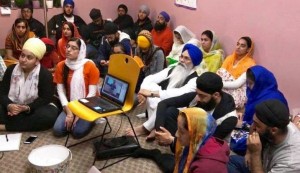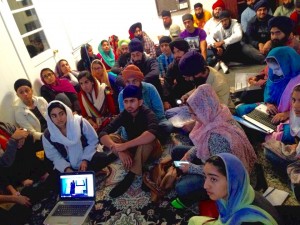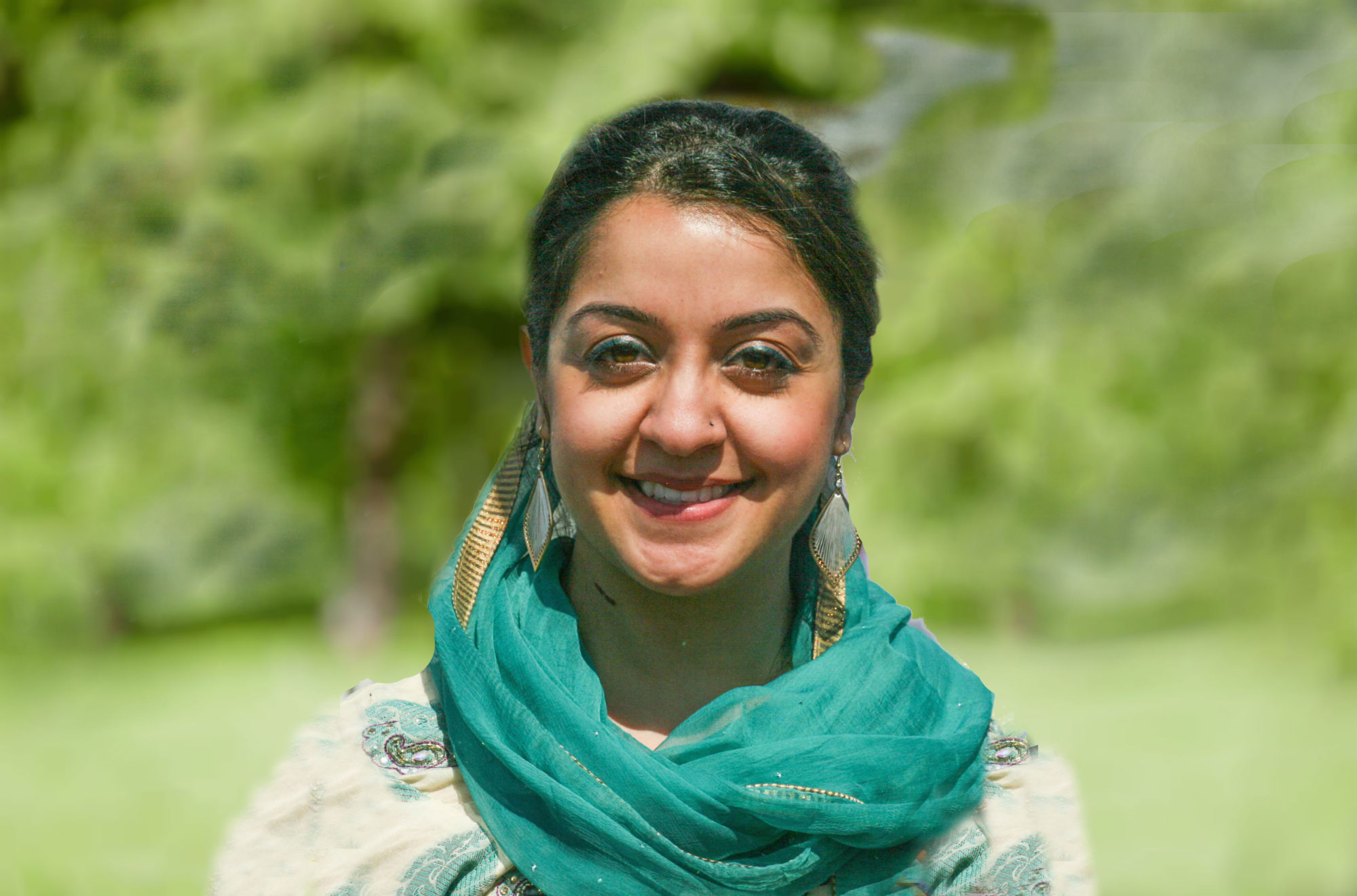When Dilroop Kaur heard about the desecration of Guru Granth Sahib Ji’s saroop, the subsequent Punjab protests, and police violence she was moved to act. “I felt like we needed to do something in regards to the events in Punjab,” she said.
So, she called together young Sikh professionals and students of the D.C. area to discuss what they, in the diaspora, could do to help their brothers and sisters in Punjab.
Then, Charanpreet Singh heard about her event and got excited to tie it into the call for Sarbat Khalsa. A Sikh history buff, he was eager to share his knowledge and passion about the Sarbat Khalsa with his sangat.
Harleen Kaur quickly joined the two and became in charge of “ethics compliance,” as Charanpreet put it, or to make sure the meeting was infused with and guided by Gurbani.
Together, these three, along with Gursean Singh, hosted a regional Sarbat Khalsa that included D.C., Maryland, and Virginia (DMV) sangats on October 16, 2015 at the Guru Gobind Singh Foundation. In total, 30 people attended and the meeting was live streamed. Bhai Sahib Gurdarshan Singh was also in attendance.
“This is a Sikh renaissance,” said Charanpreet. “We, as a panth, are starting to get away from the colonial and western mindset and focusing on adopting a Guru mind set.”
 The group tried hard to follow historic Sarbat Khalsa procedures that Charan Singh had made himself familiar with. The meeting started with putting the current Punjab situation into context. Charan talked about Punjab leadership and politics. Dilroop then tied in farmer and agricultural issues. The group also referenced Harinder Singh’s (of SikhRI) podcast on cultural and religious happenings of Punjab in the last 30 years. Finally, Harleen referenced Gurbani to bring a well-rounded aspect to the meeting.
The group tried hard to follow historic Sarbat Khalsa procedures that Charan Singh had made himself familiar with. The meeting started with putting the current Punjab situation into context. Charan talked about Punjab leadership and politics. Dilroop then tied in farmer and agricultural issues. The group also referenced Harinder Singh’s (of SikhRI) podcast on cultural and religious happenings of Punjab in the last 30 years. Finally, Harleen referenced Gurbani to bring a well-rounded aspect to the meeting.
Harleen also outlined the norms of collaboration so everyone was on the same page on how to work together and create a safe and equitable space. With the help of SAFAR, Harleen outlined the three norms for the group: Pay attention to self & others, presume positive intentions, and recognize your power & privilege.
Once the history of the Sarbat Khalsa was explained, the sangat all agreed they wanted to hold their own regional Sarbat Khalsa so the group moved to the divan hall to continue in the presence of Guru Granth Sahib.
“The conversation happened organically,” said Charanpreet. “It was an open forum where everyone expressed their thoughts.” It was an open discussion and in the classic nature of Sarbat Khalsa, the entire sangat contributed.
The group passed the following resolutions:
1: The Sangat that met on 2nd Katik 547 (10/16/15) at Guru Gobind Singh Foundation resolves to meet on a regular basis using the Sarbat Khalsa model of deliberation
2: We reject SGPC’s and SAD (B)’s attempt to control local D.C. Maryland and Virginia Gurduaras
3: Resolve to make concept of Sarbat Khalsa deliberation viral
4: We agree to MEET AGAIN Friday October 23rd (8pm; GGSF) – electronic access available
5: We salute our martyrs who gave their lives for Guru Granth and Guru Panth and support the injured and protesting in Panjab and the Sikh diaspora
6: We condemn Panjab police brutality and the deception by the current leadership of SAD (B), SGPC, and the administration and Jathedars of all five Takhts
7: We resolve to boycott Badal’s financial interests (PTC etc.) and request the Khalsa Panth to follow suit in Panjab and worldwide.
8: We resolve to collect information about current events in Panjab for distribution and strategic planning.
The following week, the sangat met again. “We had an overwhelmingly positive response,” said Charanpreet. Over 70 people attended. “We didn’t know how to deal with so many people,” he said. The three explained how hosting the regional Sarbat Khalsa was a learning process, a work in progress, and with each meeting they were able to tweak and refine the format.
“At the second meeting, we chose four resolutions for which we wanted to create action plans,” said Harleen Kaur.
 The DMV sangat was one of the first regional Sarbat Khalsa and thus, many sangats across the nation looked to them as an example on how to model their own meetings. Many of the materials they developed were also shared amongst gurdwaras.
The DMV sangat was one of the first regional Sarbat Khalsa and thus, many sangats across the nation looked to them as an example on how to model their own meetings. Many of the materials they developed were also shared amongst gurdwaras.
“We contacted other gurdwaras and told them if they passed resolutions, we would post them to our site,” said Dilroop.
This website serves as a repository and resource page for others. It was put together by a national team that had been researching Sarbat Khalsa for a couple of years. “That team has a bunch of members and some of them, like myself and Gursean, just happened to be from DMV area so it was an easy partnership,” said Charanpreet.
When the larger, North American Sarbat Khalsa was held in Yuba City, Harmeet Kaur and Gursean Singh (part of the aforementioned website team) attended with the DMV resolutions in mind. Upon attending, they realized many Sikh across North America were thinking the same things and had similar thoughts and concerns.
Charan, Harleen, and Dilroop were thrilled about the possibilities of Sarbat Khalsa and how reviving the institution could help the panth grow and progress.
“I am excited that the Guru is coming back to life in our collective psyche.” said Chraanpreet. “The Sarbat Khalsa is a gift, it is a way for us to become truly sovereign and I think people are waking up to that.”
Dilroop echoed his sentiment. “I want the revolution to continue,” she said. “We took a small step and I hope it keeps going. I hope people don’t get frustrated by setbacks; it took the Gurus 300 years to create the Khalsa.”
Dilroop’s motivation for continuing to work for change: “I am sick of corrupt uncles in Punjab. I want everyone to have a voice.”
“We need to think of the unheard and disenfranchised,” said Harleen Kaur. “My biggest fear is that we might create the same power dynamic that we are trying to fight against. One way to prevent that is by making sure we are aligned with and inspire by Gurbani.”
Harleen added, “I am very hopeful. We have to chip away at the current negative narrative and create an effective counter-story. My hope is that in the future, marginalized voice of the panth are heard.”
In regards to how one can help those who are unheard Harleen Kaur said, “Guru Nanak used his privilege to make Gurbani and the Divine accessible. We too can use our privilege as allies and advocates.”
Though the November 2015 Sarbat Khalsa has already occurred, there are many ways individuals can still be involved in strengthening the Sikh panth.
“Educate yourself on Sikh issues and Sarbat Khalsa,” said Charanpreet. “Visit our website. You can always reach out to us if you need help.”
“It’s really interesting to learn about,” said Dilroop who suggested to join an existing group or to find like-minded people to connect with. “You can create action plans to carry out Sarbat Khalsa resolutions or, if you don’t like the resolutions that were passed, get ready for the next Sarbat Khalsa in Vaisakhi of 2016.”
Harleen added, “Marginalized groups who may not have been heard at this Sarbat Khalsa, like women or non-Punjabi Sikhs, can join together and use this event as a springboard for the next Sarbat Khasla.”
Another way people can get involved is by attending a regional DMV meeting to see how a Sarbat Khalsa operates. “Sometimes, it may be hard to understand concepts without seeing it in real life,” Harleen said. “We strive to be open and transparent. Come and watch.”
She also said that adopting a positive mindset, focusing on commonalities, and thinking in global ways, yet acting locally, can help create an environment conducive to a regional Sarbat Khalsa.
“Remember, it takes time and it’s all a work in progress,” said Charanpreet. “I’m excited about it all.”
Photos from: https://www.facebook.com/groups/1517044628612373/




